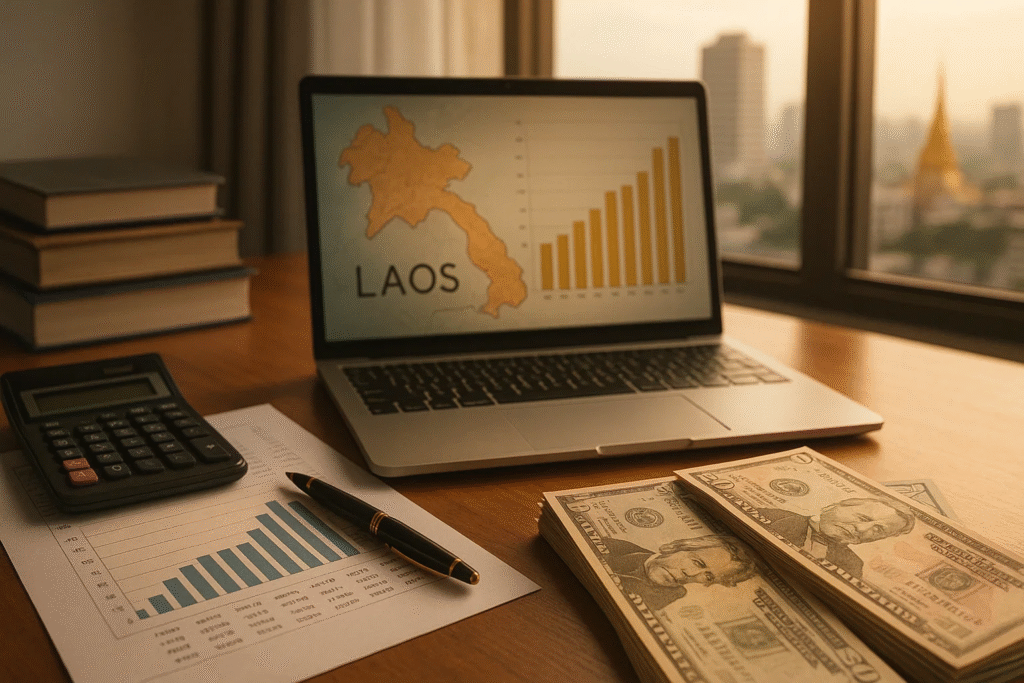Key Takeaways
- Salaries in Laos are projected to rise moderately in 2026, driven by inflation and regional wage competition.
- Skilled labor shortages and migration pressures are reshaping compensation strategies across industries.
- Employers must focus on non-cash benefits, upskilling, and regional benchmarking to retain top talent effectively.
Understanding the evolving salary landscape in Laos for 2026 is vital for professionals, businesses, and policymakers navigating the country’s fast-changing economic environment. As one of Southeast Asia’s developing economies, Laos is experiencing steady growth driven by foreign investment, cross-border trade, and an expanding private sector. This growth is reshaping the labor market, influencing salary structures, and redefining workforce expectations across key industries such as manufacturing, construction, banking, tourism, and technology.

The year 2026 is expected to mark a significant turning point in Laos’s wage and employment ecosystem. The government continues to focus on improving minimum wage policies, enhancing workforce productivity, and promoting sustainable economic diversification. With increasing competition for skilled talent, employers are being urged to rethink their compensation strategies, ensuring they remain attractive to both local and expatriate professionals. Meanwhile, employees are paying closer attention to pay transparency, job security, and career development opportunities, driving greater discussions about equitable pay and performance-based incentives.
This comprehensive guide provides an in-depth analysis of salary trends and wage structures in Laos for 2026, covering everything from average income levels by sector to regional pay differences and tax implications. Readers will gain valuable insights into how salaries vary across industries such as education, healthcare, engineering, IT, and hospitality, as well as how factors like experience, qualifications, and location influence overall earnings.
Additionally, this guide explores the broader economic and social factors shaping Laos’s wage outlook, including inflation, foreign investment flows, and government reforms aimed at strengthening labor protections. It also highlights how globalization, remote work opportunities, and ASEAN integration are impacting the demand for skilled workers in high-growth sectors.
Whether you are an employer benchmarking compensation packages, an expatriate evaluating relocation opportunities, or a local professional seeking to understand your earning potential, this 2026 salary guide offers reliable, research-backed insights to help you make informed decisions. By understanding the current and projected wage dynamics in Laos, individuals and organizations alike can better position themselves for success in the country’s evolving employment landscape.
Ultimately, this complete guide to salaries in Laos for 2026 serves as a valuable resource for anyone interested in the intersection of economics, employment, and workforce development in one of Southeast Asia’s emerging markets. It not only outlines the latest data and trends but also provides practical perspectives on how these changes will affect hiring, retention, and career planning in the years ahead.
Before we venture further into this article, we would like to share who we are and what we do.
About 9cv9
9cv9 is a business tech startup based in Singapore and Asia, with a strong presence all over the world.
With over nine years of startup and business experience, and being highly involved in connecting with thousands of companies and startups, the 9cv9 team has listed some important learning points in this overview of Salaries in Laos for 2026: A Complete Guide.
If your company needs recruitment and headhunting services to hire top-quality employees, you can use 9cv9 headhunting and recruitment services to hire top talents and candidates. Find out more here, or send over an email to [email protected].
Or just post 1 free job posting here at 9cv9 Hiring Portal in under 10 minutes.
Salaries in Laos for 2026: A Complete Guide
- Executive Summary: Navigating 2026 Salary Dynamics in the Lao PDR
- Macroeconomic Context Shaping 2026 Compensation
- Statutory Compensation and Market-Wide Benchmarks
- Detailed Salary Benchmarks by Job Function and Experience (2026 Projection)
- Compliance, Taxation, and Net Compensation
- Strategic Labor Market Challenges and 2026 Outlook
- Strategic Recommendations for Compensation Planning in 2026
1. Executive Summary: Navigating 2026 Salary Dynamics in the Lao PDR
a. Key Compensation Snapshot (2025/2026 Baseline)
Executive Overview: Understanding Salary Trends and Compensation Structures in Laos for 2026
The salary landscape in the Lao People’s Democratic Republic (Lao PDR) in 2026 is expected to evolve amid ongoing economic reforms and demographic transitions. The government’s efforts to maintain monetary stability and manage inflation have created a cautiously optimistic economic environment. However, despite these macroeconomic interventions, underlying challenges such as real wage stagnation, labor migration, and skill shortages continue to shape the country’s overall compensation framework.
Economic stabilization has played a pivotal role in easing inflationary pressures, allowing employers to adopt more structured compensation models. Yet, rising living costs and the widening disparity between minimum wage and actual living expenses continue to drive workers toward regional labor markets, particularly Thailand and Vietnam. The 2026 salary environment in Laos, therefore, reflects a balancing act between economic growth objectives and the need for sustainable wage policies that retain local talent.
Key Insights into Compensation Landscape (2025–2026 Baseline)
• The statutory minimum wage in Laos has been officially set at LAK 2,500,000 per month, effective from October 2024. This adjustment was introduced as part of the government’s response to mitigate the escalating cost of living and inflationary pressures.
• Despite the increase, the legal minimum remains below the actual cost of sustaining a household, as indicated by labor market studies and regional benchmarks.
• The median monthly salary across industries stands at approximately LAK 3,500,000, highlighting a moderate improvement compared to the previous year but still insufficient to meet the estimated living wage threshold.
• The rural Living Wage Reference Value is projected at around LAK 4,056,905 per month for 2025, signifying the amount required for workers to achieve a decent standard of living without economic vulnerability.
The divergence between the minimum wage, median market wage, and living wage demonstrates the underlying strain in Laos’s labor market. Employers are increasingly facing challenges in attracting and retaining skilled professionals, especially as neighboring economies continue to offer more competitive compensation packages.
Comparative Salary Analysis (2025–2026 Estimates)
| Salary Metric | 2025 Estimate (LAK/month) | 2026 Projection (LAK/month) | Year-on-Year Change (%) |
|---|---|---|---|
| Minimum Wage | 2,500,000 | 2,700,000 (expected) | +8% |
| Median Market Salary | 3,500,000 | 3,850,000 | +10% |
| Living Wage (Urban) | 4,700,000 | 5,100,000 | +8.5% |
| Living Wage (Rural) | 4,056,905 | 4,350,000 | +7.2% |
This table highlights that while nominal wages are projected to increase in 2026, the growth rate may not fully offset inflationary pressures or the rising cost of essential goods and services. The labor market is therefore expected to remain tight, with wage-driven migration posing a continuous challenge for employers in manufacturing, construction, and hospitality sectors.
Labor Market Dynamics Influencing Salary Growth
• Inflation Control Measures: Monetary tightening by the central bank has contributed to greater price stability, yet wage adjustments have lagged behind inflation recovery rates.
• Talent Migration: Outflows of skilled labor to neighboring ASEAN countries have intensified, leading to local labor shortages and upward wage pressures in technical and service-oriented fields.
• Private Sector Adjustments: Multinational and private enterprises have started implementing differentiated pay structures to align with performance, productivity, and retention objectives.
• Sectoral Variations: Industries such as mining, logistics, finance, and IT offer significantly higher remuneration compared to agriculture or retail, reflecting disparities in skill demand and sector profitability.
Projected Outlook for 2026
The salary trajectory for 2026 in Laos suggests gradual but uneven wage growth across different economic sectors. While the government continues to prioritize equitable wage distribution and improved labor standards, real progress will depend on macroeconomic stability, foreign investment inflows, and skill development initiatives.
Employers in Laos are expected to adopt data-driven compensation strategies, benchmarking salaries regionally to remain competitive within ASEAN. This will include the introduction of incentive-based pay systems and enhanced employee benefits to offset cost-of-living concerns.
Overall, the 2026 salary environment in Laos underscores the importance of aligning national wage policies with regional competitiveness. With the widening gap between statutory and living wages, both public and private stakeholders must collaborate to ensure sustainable wage growth that fosters economic inclusion and long-term workforce stability.
b. 2026 Outlook and Strategic Imperative
2026 Economic Outlook and Strategic Salary Imperatives in Laos
The economic outlook for Laos in 2026 reflects cautious optimism as the nation emerges from several years of financial volatility and inflationary strain. According to projections by the Asian Development Bank, inflation is expected to moderate to approximately 10.4%, a notable improvement from the estimated 13.5% in 2025. This gradual stabilization is anticipated to pave the way for the first signs of real wage growth, offering employers a window of opportunity to recalibrate compensation strategies and restore workforce confidence.
Yet, despite these positive macroeconomic signals, the Lao labor market continues to grapple with deep structural challenges. The talent gap remains most pronounced in sectors tied to foreign direct investment (FDI) such as Information Technology (IT), Logistics, and Hydropower. These industries form the backbone of Laos’s modernization and export-driven growth but face persistent labor shortages due to the migration of skilled workers seeking higher pay in neighboring ASEAN economies like Thailand, Vietnam, and Cambodia.
Key Economic Indicators Influencing Salaries (2025–2026 Projection)
| Indicator | 2025 Estimate | 2026 Projection | Trend Analysis |
|---|---|---|---|
| Inflation Rate | 13.5% | 10.4% | Moderate decline, easing pressure |
| GDP Growth Rate | 3.8% | 4.5% | Gradual recovery |
| Real Wage Growth Potential | -1.2% | +1.8% | Signs of stabilization |
| Labor Migration (Outbound, skilled labor) | High | High (sustained) | Continues to strain local supply |
| FDI Inflow (Yearly) | Moderate | High | Boosted by energy and logistics |
This data matrix illustrates a cautiously improving economic environment, yet the sustainability of real wage growth will depend largely on how employers respond to labor market pressures and align salary strategies with cost-of-living realities.
Talent Competition and Regional Benchmarking
• Cross-Border Wage Pressures: The wage gap between Laos and neighboring economies remains significant. For instance, IT professionals in Thailand can earn up to twice as much as their counterparts in Laos, incentivizing continuous labor migration.
• High-Value Sector Shortages: Hydropower and logistics enterprises are particularly vulnerable to attrition, as they rely heavily on technical expertise that remains scarce in the domestic market.
• Rising Cost of Living: Inflationary aftershocks from previous years continue to elevate household expenses, forcing employers to introduce compensation packages that go beyond statutory wage levels.
• Private Sector Adaptation: Forward-thinking organizations are beginning to shift toward value-based compensation models that emphasize long-term retention through both monetary and non-monetary incentives.
Strategic Compensation Priorities for 2026
To remain competitive in 2026, employers in Laos must adopt multi-dimensional compensation strategies designed to address the realities of a dynamic and globally interconnected labor market. These strategies include:
• Beyond Minimum Wage Compliance: Paying merely the legal minimum of LAK 2,500,000 per month is insufficient to attract or retain talent. Employers must realign their pay scales to reflect living wage standards, which exceed LAK 4,000,000 in many urban centers.
• Enhanced Non-Cash Benefits: Companies are increasingly offering benefits such as healthcare, transportation allowances, remote work flexibility, and skill development programs to counterbalance wage disparities.
• Rigorous Regional Benchmarking: Employers must continually assess compensation trends across ASEAN to ensure pay competitiveness. Benchmarking data from markets like Vietnam, Malaysia, and Thailand serves as a critical reference for setting appropriate salary levels in technical and managerial roles.
• Localized Retention Programs: Implementing retention-based bonuses and structured career progression plans has proven effective in reducing turnover, especially in industries reliant on skilled technical personnel.
Projected Compensation Strategies for Key Sectors (2026 Forecast)
| Sector | Primary Challenge | Recommended HR Strategy | Expected Salary Adjustment (%) |
|---|---|---|---|
| Information Technology | Talent migration to Thailand & Vietnam | Regional benchmarking, remote hiring incentives | 10–15% increase |
| Logistics | High operational cost & attrition | Training subsidies, performance-linked bonuses | 8–12% increase |
| Hydropower | Technical labor shortage | Specialist retention bonuses, skill development | 12–18% increase |
| Manufacturing | Rising input costs | Productivity-linked pay structures | 6–9% increase |
| Services & Retail | Inflationary wage compression | Benefits expansion, flexible work arrangements | 5–8% increase |
This matrix underscores that salary adjustments across sectors will vary depending on competitiveness, skill intensity, and exposure to foreign investment. IT and hydropower sectors, in particular, will continue to lead compensation growth due to sustained talent scarcity.
Conclusion: Strategic Imperatives for Sustainable Wage Growth
The 2026 salary landscape in Laos presents both challenges and opportunities for employers. While macroeconomic stabilization is encouraging, true wage resilience will depend on strategic foresight, competitive benchmarking, and a renewed focus on workforce well-being.
Employers who adapt to these evolving trends—by aligning pay structures with real living standards, fostering skill retention, and offering holistic compensation—will not only navigate inflationary uncertainty but also strengthen their position in Laos’s rapidly transforming labor market.
2. Macroeconomic Context Shaping 2026 Compensation
a. Economic Performance and Drivers (2025-2026 Forecasts)
Macroeconomic Context Influencing Compensation Trends in Laos for 2026
The salary and compensation framework across the Lao People’s Democratic Republic (Lao PDR) in 2026 will be strongly shaped by the nation’s evolving macroeconomic environment. Economic resilience, foreign investment inflows, infrastructure modernization, and shifting labor market dynamics collectively form the foundation of how wages are determined and adjusted across industries. As Laos continues its gradual post-crisis recovery, compensation policies are increasingly expected to align with national growth patterns and regional competitiveness within the ASEAN bloc.
Economic Performance and Key Growth Drivers (2025–2026 Forecasts)
The Lao economy is projected to expand at a moderate pace, signaling cautious optimism following several years of financial instability. Based on regional forecasts, the economy is expected to grow by approximately 3.7% in 2025 and strengthen to about 4.0% in 2026. This economic expansion is predominantly supported by capital-intensive and service-oriented sectors, particularly logistics, energy, tourism, and mining.
| Sector | 2025 GDP Growth (%) | 2026 GDP Growth (%) | Key Growth Drivers | Wage Implications |
|---|---|---|---|---|
| Logistics & Transport | 5.2 | 6.0 | Laos-China Railway operations, trade corridor expansion | Rising demand for engineers, managers |
| Tourism & Hospitality | 4.8 | 5.3 | Regional travel recovery, cross-border connectivity | Moderate wage recovery in service jobs |
| Mining & Energy | 3.5 | 4.2 | Hydropower expansion, foreign investment projects | Competitive salaries in technical roles |
| Agriculture | 1.4 | 1.3 | Climate risk, low productivity | Wage stagnation in rural areas |
| Manufacturing | 3.1 | 3.6 | Light industry recovery, foreign trade linkages | Slow wage growth, limited mobility |
The table highlights that growth momentum remains uneven across industries, with logistics, energy, and tourism leading the recovery while agriculture continues to lag due to structural inefficiencies and environmental challenges.
Infrastructure and Logistics as Compensation Catalysts
The Laos-China Railway (LCR), operational since late 2021, continues to serve as a transformational infrastructure backbone for Laos. This strategic corridor has dramatically improved connectivity, reducing logistics costs by nearly 40% and positioning Laos as a critical gateway for trade between China and the ASEAN region.
This development has had a profound influence on the compensation landscape:
• Localized Wage Inflation – Areas along the railway route, particularly Vientiane, Luang Namtha, and Oudomxay, have experienced a surge in average wages due to concentrated industrial and construction activity.
• High Demand for Skilled Professionals – Engineers, project managers, and technicians remain in short supply, forcing companies to offer higher-than-average compensation packages to attract qualified candidates.
• Construction and Supply Chain Premiums – The logistics boom has led to salary premiums of 15–25% in construction and supply chain management roles compared to the national median.
• Regional Competition for Talent – Employers in these sectors face growing pressure from neighboring markets such as Thailand and Vietnam, where similar roles command higher compensation, prompting Lao companies to engage in regional benchmarking and incentive-based pay strategies.
Sectoral Wage Dynamics and Employment Impact
The ongoing expansion in logistics and infrastructure directly correlates with higher salary dispersion across the Lao labor market. While the urban workforce benefits from these structural investments, rural employment, particularly in agriculture, remains vulnerable to stagnation.
| Employment Category | Average Monthly Salary (LAK) | 2026 Projected Growth (%) | Key Influencing Factors |
|---|---|---|---|
| Construction & Engineering | 5,800,000 | +12.5 | Infrastructure projects, LCR expansion |
| Logistics & Supply Chain | 5,500,000 | +11.3 | Increased freight and transport demand |
| Energy & Hydropower | 6,200,000 | +13.8 | New hydropower plants, foreign investments |
| Tourism & Services | 3,700,000 | +8.2 | Rebound in travel and hospitality |
| Agriculture | 2,200,000 | +2.1 | Limited technological adaptation, climate pressures |
This wage matrix indicates a widening income gap between the capital-intensive and rural sectors, driven primarily by labor demand concentration in urban and industrial centers. The construction, logistics, and hydropower industries will likely continue leading salary growth trajectories into 2026.
Strategic Implications for Employers
To navigate this evolving salary environment, employers in Laos must develop compensation frameworks that are adaptive, equitable, and aligned with macroeconomic realities. Key strategic actions include:
• Data-Driven Salary Planning – Employers should incorporate GDP growth, inflation forecasts, and cost-of-living adjustments into annual wage reviews to maintain competitive and sustainable pay structures.
• Regional Benchmarking – Establishing salary benchmarks based on ASEAN averages, especially for technical and managerial roles, will be crucial for attracting skilled labor.
• Workforce Localization Initiatives – Incentivizing local workforce development through training and skill enhancement can reduce dependency on expatriate expertise in specialized sectors.
• Comprehensive Benefits Packages – In addition to higher base salaries, companies should consider adding non-cash incentives such as housing allowances, insurance, and professional development grants to improve retention.
Conclusion: The Interplay of Economic Growth and Wage Evolution
As Laos enters 2026, the relationship between economic expansion and wage development will become increasingly interlinked. The country’s ability to sustain real wage growth depends on continued infrastructure investment, effective labor market reforms, and a strong alignment between pay policies and productivity outcomes.
In summary, while Laos’s economy is poised for steady growth, compensation trends will remain highly differentiated by sector. Employers who adopt forward-looking salary strategies, regional benchmarking, and holistic employee value propositions will be best positioned to navigate the challenges and capitalize on the opportunities of the 2026 labor market.
b. Inflation, Currency Depreciation, and the Real Wage Crisis
Inflation, Currency Depreciation, and the Real Wage Crisis in Laos
The salary structure in Laos for 2026 cannot be accurately understood without considering the powerful influence of inflation and currency depreciation on real incomes. These twin economic forces have redefined the compensation landscape, affecting both employee purchasing power and employer payroll strategies. Although headline inflation figures suggest short-term stabilization, deeper analysis reveals persistent long-term structural pressures that continue to erode real wages and constrain living standards.
Overview of Inflation Trends and Monetary Stabilization
Throughout 2025, Laos witnessed a notable deceleration in inflation rates—from over 15% at the beginning of the year to approximately 4.5% in September and 4.0% in October. This sharp decline was largely attributed to the Bank of the Lao PDR’s tightened monetary policies, currency interventions, and fiscal controls designed to contain price volatility. These measures temporarily alleviated inflationary pressures on consumer goods and essential commodities.
However, despite this progress, medium-term inflation projections from regional financial institutions remain elevated. The Asian Development Bank anticipates inflation levels to average 13.5% in 2025 and moderate to 10.4% in 2026. This outlook reflects the persistent structural challenges facing Laos, including the burden of foreign currency-denominated debt, rising import costs, and the pass-through effects of higher energy and utility tariffs.
| Year | Headline Inflation (%) | Core Inflation (%) | Real Wage Growth (%) |
|---|---|---|---|
| 2023 | 18.2 | 15.1 | -5.8 |
| 2024 | 15.0 | 12.4 | -3.9 |
| 2025 | 13.5 (forecast) | 10.8 (forecast) | 0.5 (stabilizing) |
| 2026 | 10.4 (forecast) | 8.9 (forecast) | +1.8 (expected rise) |
The table demonstrates that while inflation is gradually declining, it remains substantially above pre-crisis levels. Real wage growth, although expected to turn positive in 2026, continues to lag behind the pace of price increases in essential goods and services.
Structural Inflation Pressures and Cost of Living Impact
Despite headline inflation moderation, core inflation—the sustained increase in non-volatile goods such as housing, energy, and healthcare—remains persistently high. These are the components that most directly affect household financial stability, and their upward trajectory continues to erode disposable income.
Key cost drivers include:
• Housing, Utilities, and Fuel – Prices have surged by an estimated 16.7% year-on-year, largely due to the government’s scheduled increase in electricity tariffs from March 2025 and higher transportation costs linked to energy imports.
• Healthcare – Medical and pharmaceutical costs have increased by approximately 12.9%, outpacing general wage adjustments in both public and private sectors.
• Education – Tuition and associated learning expenses have climbed by around 11.5%, placing additional pressure on family budgets and limiting long-term workforce savings potential.
These structural price increases highlight that the average household’s cost of living is expanding faster than wage growth, despite a stable consumer price index (CPI). Consequently, employers relying solely on CPI figures risk underestimating the true extent of wage erosion experienced by their workforce.
Purchasing Power and Income Parity Context
In 2024, Laos recorded a GDP per capita based on purchasing power parity (PPP) of approximately USD 8,610.90—equivalent to only 48% of the global average. This disparity underscores the limited purchasing power of Lao citizens in comparison with global standards and reflects the real economic burden faced by working households.
| Indicator | 2024 Estimate | Global Average | Laos as % of Global Average |
|---|---|---|---|
| GDP per Capita (PPP, USD) | 8,610.90 | 17,900.00 | 48% |
| Average Annual Salary (USD, est.) | 4,300.00 | 10,200.00 | 42% |
| Cost of Living Index (relative) | 68.5 | 100.0 | -31.5% lower purchasing power |
The matrix illustrates that although Laos maintains a lower nominal cost of living compared to developed economies, inflationary volatility and weak real wage growth have reduced household purchasing power substantially.
Implications for Compensation Planning in 2026
Given the continuing mismatch between nominal wage growth and cost-of-living increases, employers in Laos face the challenge of maintaining workforce morale and financial stability while managing operational costs. A forward-thinking compensation strategy for 2026 must therefore prioritize real income protection and inflation resilience.
Strategic imperatives include:
• Inflation-Indexed Pay Adjustments – Salaries should be reviewed semi-annually and tied to both headline and core inflation indicators to prevent wage stagnation.
• Targeted Support for Essential Costs – Introducing allowances or subsidies for housing, utilities, and transportation can offset the impact of rising living costs.
• Performance and Productivity Bonuses – Linking variable pay components to company performance can enhance income flexibility without inflating fixed payroll obligations.
• Employee Financial Wellness Programs – Offering financial literacy and savings support initiatives can help employees manage inflationary stress and improve retention.
Conclusion: Navigating the Real Wage Crisis
In 2026, Laos’s economic narrative is defined by cautious recovery and ongoing vulnerability to inflationary shocks. While headline inflation is forecast to decline, its structural components remain entrenched, creating continued strain on household budgets. Real wage growth will only become sustainable when compensation frameworks account for the true cost of living rather than nominal price trends.
For employers and policymakers alike, the path forward requires a shift toward data-driven wage planning, transparency in compensation policies, and targeted benefits that directly alleviate inflation’s impact. Only through such adaptive strategies can Laos move toward achieving genuine wage stability and improved living standards for its workforce in 2026 and beyond.
c. Policy and Regulatory Environment Impacting 2026 Compensation
The salary and compensation outlook in Laos for 2026 will be profoundly shaped by two pivotal policy and regulatory developments that hold long-term implications for labor markets, investment confidence, and executive remuneration across the country.
Graduation from Least Developed Country (LDC) Status
Laos is on track to officially graduate from its Least Developed Country status by November 2026, marking a major milestone in its national development trajectory. This transition signals progress in several key socio-economic indicators, including income levels, human capital, and economic resilience. However, it also introduces new challenges that will directly impact wage structures and labor competitiveness:
- Trade and Market Access Evolution: Post-graduation, Laos is expected to gain improved access to international markets through diversified trade frameworks. The country’s shift from preferential to competitive trade terms will incentivize industries to upgrade productivity and skill development, driving upward adjustments in professional and technical wage categories.
- Human Resource Development Priorities: To sustain growth, the Lao government is anticipated to channel greater investments into workforce upskilling, vocational training, and education reforms. This move will likely result in wage differentiation, with higher premiums offered to skilled professionals and managerial-level talent.
- Transition and Adjustment Risks: Despite the opportunities, the withdrawal of certain development aid packages could create short-term fiscal constraints, especially in public sector compensation and infrastructure-linked employment.
Implications of FATF Grey List Inclusion
In contrast, the country’s inclusion on the Financial Action Task Force (FATF) grey list in February 2025 introduces external financial and regulatory headwinds that may influence corporate pay strategies and foreign investment decisions in 2026.
- Heightened Financial Scrutiny: The grey list classification places Laos under increased observation for its anti-money laundering and counter-terrorism financing frameworks. As a result, international banking transactions and cross-border capital inflows face more stringent checks, potentially slowing FDI momentum.
- Impact on Foreign Direct Investment (FDI): With FDI contributing to approximately 95.7% of investment in major industries such as hydropower, mining, and infrastructure, the prolonged presence on the grey list could elevate borrowing costs and discourage large-scale project financing. This development could dampen salary progression, particularly for expatriate executives, project directors, and financial specialists linked to foreign-funded ventures.
- Corporate Compensation Strategies: Organizations reliant on FDI-driven capital must now adopt adaptive compensation frameworks. Salary increments for top-tier professionals may remain conservative in 2026, balancing between maintaining competitiveness and mitigating liquidity risks caused by delayed capital inflows.
Table: Policy and Economic Factors Influencing 2026 Salary Trends in Laos
| Key Policy Event | Expected Timeline | Direct Impact on Compensation | Affected Sectors |
|---|---|---|---|
| LDC Graduation | November 2026 | Wage increase for skilled and professional tiers due to enhanced global competitiveness | Manufacturing, ICT, Education, Tourism |
| FATF Grey List Inclusion | February 2025 (Ongoing) | Slower wage growth for expatriates and executives in FDI-dependent industries | Mining, Hydropower, Construction, Finance |
Overall Economic Implications
The convergence of these two policy factors will define a dual-track compensation outlook for 2026. While the LDC graduation is set to boost professional wage levels through improved trade conditions and productivity demands, the ongoing FATF scrutiny may restrict rapid pay growth in investment-heavy sectors. Consequently, the Lao labor market in 2026 is likely to experience moderate but uneven salary growth — stronger in domestically driven industries and cautious in FDI-reliant domains.
This evolving policy landscape underscores the need for organizations to adopt forward-looking compensation frameworks that integrate regulatory, financial, and macroeconomic variables, ensuring sustainable salary competitiveness amid Laos’s transition toward a more globally integrated economy.
3. Statutory Compensation and Market-Wide Benchmarks
a. Official Minimum Wage and Living Wage Disparity
Understanding the statutory compensation framework and how it compares to real market practices is essential to assessing the evolving salary landscape in Laos for 2026. The disparity between official wage regulations and market-driven pay rates has significant implications for workforce retention, labor mobility, and the overall economic stability of the country.
National Minimum Wage and Its Economic Context
The Lao government implemented a significant upward revision of the official National Minimum Wage, raising it to LAK 2,500,000 per month as of October 1, 2024. This adjustment represented an approximate 56 percent increase from the previous rate, introduced as an emergency measure to counteract the inflationary pressures that had sharply eroded household purchasing power.
However, despite this statutory increase, the real-world dynamics of labor supply and demand have created a market-based wage floor that surpasses the official minimum. Most private sector employers, particularly in urbanized and industrial zones such as Vientiane, Luang Prabang, and Savannakhet, now offer starting salaries ranging between LAK 3,500,000 and LAK 4,500,000 per month. This divergence reflects the private sector’s need to attract and retain workers amid escalating living costs and limited skilled labor availability.
Living Wage as a Realistic Benchmark for Workforce Sustainability
While the official minimum wage serves as the legal baseline, the concept of the living wage offers a more accurate representation of what constitutes a sustainable and dignified income. As of 2025, the estimated living wage for rural Laos stands at approximately LAK 4,056,905 per month, based on calculations that consider essential living expenses such as housing, food, healthcare, transportation, and education.
The gap between the legal minimum wage and the living wage underscores a growing structural challenge. Employees earning below the LAK 4 million threshold face considerable financial strain, which can lead to higher turnover rates, reduced productivity, and labor shortages in critical sectors. For employers, aligning salary strategies with the living wage is increasingly viewed not only as an ethical imperative but also as a pragmatic approach to ensuring long-term organizational stability and labor market competitiveness.
Comparative Overview of Wage Indicators in Laos (2025 Baseline)
| Wage Indicator | Monthly Salary (LAK) | Approximate USD Equivalent | Economic Significance |
|---|---|---|---|
| Official National Minimum Wage (Effective Oct 2024) | 2,500,000 | ~115–120 USD | Legal wage floor; insufficient to meet modern living standards. |
| Median Monthly Income | 3,500,000 | ~161 USD | Represents the income midpoint; half of workers earn below this amount. |
| Rural Living Wage Reference (2025 Estimate) | 4,056,905 | ~187 USD | Minimum income required for a decent rural standard of living. |
| Average Monthly Salary (All Sectors) | 4,000,000 | ~226 USD | National average; elevated by management and specialized professional roles. |
Market Implications for 2026 Salary Structures
As Laos advances toward its 2026 development milestones, including its anticipated graduation from Least Developed Country status, the widening wage gap between statutory and real labor market levels will remain a key area of focus for policymakers and employers alike.
- Urban vs. Rural Wage Divergence: Urban centers are expected to maintain wage premiums due to higher living costs, stronger labor demand, and expanding service sectors.
- Private Sector Responsiveness: Competitive employers are increasingly benchmarking against the living wage rather than the statutory minimum to reduce attrition and enhance employer branding.
- Inflation-Linked Adjustments: Salary reviews will likely integrate cost-of-living escalators to maintain real wage parity amid continued price volatility.
Chart: Laos Wage Structure Overview (2025–2026 Projection)
A simplified visualization of wage tiers in Laos shows the relative gap between policy-defined and market-driven wage levels:
| Category | Monthly Pay Range (LAK) | Comparative Level |
|---|---|---|
| Official Minimum Wage | 2,500,000 | Baseline (100%) |
| Market Entry-Level Pay | 3,500,000 – 4,500,000 | 140% – 180% of baseline |
| Living Wage Threshold | 4,056,905 | 162% of baseline |
| Urban Average Salary | 5,000,000 – 6,000,000 | 200% – 240% of baseline |
This structure highlights how the Lao economy is gradually transitioning from a low-wage framework to a cost-adjusted pay environment. For employers developing 2026 salary strategies, anchoring compensation closer to the living wage benchmark rather than the statutory minimum will be vital for sustaining workforce morale, productivity, and retention in an increasingly competitive regional labor market.
b. General Salary Distribution and Geographical Differentials
The salary landscape in Laos for 2026 presents a wide spectrum of income levels, reflecting the country’s diverse economic sectors, varying skill demands, and sharp regional cost-of-living contrasts. Understanding this salary distribution and its geographical variations is essential for employers developing equitable and competitive compensation frameworks.
Overall Salary Landscape in Laos
Across the Lao labor market, monthly salaries range from as low as LAK 1,000,000 for entry-level or informal workers to as high as LAK 12,781,570 for highly specialized professionals and senior executives. The national average salary stands at approximately LAK 4,000,000 per month, equivalent to around 226 USD. This figure, while indicative of the general wage trend, conceals significant differences across industries, qualifications, and geographical areas.
Low-income earners are typically concentrated in agriculture and unskilled labor segments, which still represent a large share of national employment. In contrast, higher salaries are observed in capital-intensive industries such as hydropower, logistics, and mining, as well as in international organizations and financial services. These sectors rely heavily on technical expertise, managerial skills, and foreign investment, thereby commanding a substantial wage premium compared to the national mean.
Table: Overview of Salary Distribution in Laos (2026 Projection)
| Salary Category | Monthly Salary Range (LAK) | Approximate USD Equivalent | Description |
|---|---|---|---|
| Low-Income Workers | 1,000,000 – 2,500,000 | ~57 – 115 USD | Typically agricultural or informal sector workers with limited formal training. |
| Mid-Level Employees | 3,000,000 – 7,000,000 | ~170 – 395 USD | Skilled workers, technicians, and professionals in growing urban sectors. |
| High-Income Professionals | 8,000,000 – 12,781,570 | ~450 – 720 USD | Senior managers, technical experts, and expatriates in capital-intensive industries. |
| National Average | 4,000,000 | ~226 USD | Average across all sectors; skewed by high earners in specialized industries. |
Regional Compensation Differences and Cost of Living
Geographical disparities in compensation are a defining feature of the Lao wage environment. Urban centers, particularly Vientiane, consistently record higher pay scales compared to rural areas due to their economic concentration, access to foreign enterprises, and substantially higher living expenses.
In Vientiane, the estimated monthly cost of living for a single individual is around 443 USD, nearly double the cost in provincial towns. This elevated expense level encompasses higher housing rents, utility bills, transportation costs, and imported goods prices. Consequently, the national average salary of 226 USD is insufficient for maintaining a stable standard of living in the capital city.
Employers operating in Vientiane or other key urban hubs must therefore budget significantly higher salary bands. Mid-level specialists and managerial employees typically require compensation between LAK 8 million and LAK 10 million per month to meet urban cost-of-living standards. This differential creates a distinct two-tier wage structure between metropolitan and rural labor markets.
Matrix: Urban-Rural Salary Comparison (2026 Estimate)
| Location | Average Monthly Salary (LAK) | Approximate USD Equivalent | Average Monthly Cost of Living (USD) | Salary-to-Cost Ratio |
|---|---|---|---|---|
| Vientiane (Capital) | 8,000,000 – 10,000,000 | ~450 – 565 | 443 | 1.01 – 1.27 |
| Luang Prabang | 5,000,000 – 6,500,000 | ~282 – 367 | 310 | 1.10 – 1.18 |
| Savannakhet | 4,000,000 – 5,000,000 | ~226 – 282 | 260 | 1.10 – 1.20 |
| Rural Provinces | 2,000,000 – 3,500,000 | ~115 – 197 | 180 | 1.08 – 1.11 |
Key Insights for 2026 Compensation Planning
- Urban Premium Effect: Salaries in Vientiane are projected to remain 60%–80% higher than rural averages due to infrastructure, market demand, and lifestyle costs.
- Inflationary Pressures: Employers must anticipate continued wage adjustments tied to inflation and urban cost-of-living fluctuations.
- Sectoral Pay Stratification: Technical and managerial professionals, especially in energy, finance, and logistics, will continue to command top-tier salaries due to skill scarcity and foreign investment inflows.
- Labor Mobility Trends: Rural-to-urban migration will persist as workers pursue higher wages in cities, potentially exacerbating labor shortages in agriculture and low-wage sectors.
Chart: Urban vs. Rural Salary Index (Base 100 = Rural Average)
| Region | Salary Index (Relative to Rural Average) |
|---|---|
| Rural Provinces | 100 |
| Savannakhet | 125 |
| Luang Prabang | 150 |
| Vientiane | 200 |
The above chart illustrates how wages in the capital can be up to twice as high as rural averages, emphasizing the structural wage disparity shaping Laos’s evolving labor economy.
In summary, the Lao salary environment for 2026 reflects a distinct dual-market structure—one driven by urban economic concentration and globalized industry participation, and another characterized by lower rural wages and subsistence employment. For businesses and policymakers, addressing this divergence through equitable compensation frameworks and regional development incentives remains critical to ensuring sustainable national income growth and workforce retention.
4. Detailed Salary Benchmarks by Job Function and Experience (2026 Projection)
a. Compensation by Experience Level
The salary structure across Laos in 2026 is highly influenced by professional experience, tenure, and job specialization. As the economy transitions toward a more diversified industrial base, the relationship between skills, seniority, and compensation becomes increasingly evident. Employers who aim to attract and retain qualified talent must adopt compensation frameworks that reflect both experience-based progression and the market’s evolving demand for technical expertise.
Compensation Progression by Experience Level
Salary progression in Laos strongly correlates with professional experience, which is often represented through age as a practical proxy for career stage. Entry-level employees typically start at modest pay levels but experience steady growth as they gain expertise and move into specialized or managerial positions. The wage curve reaches its peak among professionals aged 35 to 44, reflecting the high market valuation of mid-career experts who combine technical capability with leadership experience.
Table: Median Monthly Salary by Experience (2026 Projection)
| Age Group | Median Monthly Salary (LAK) | Approximate USD Equivalent | Career Stage | Observations |
|---|---|---|---|---|
| Under 24 | 3,200,000 | ~180 | Entry-Level / Recent Graduates | Limited practical experience; common in service, hospitality, and entry clerical roles. |
| 25–34 | 4,200,000 | ~236 | Early-Career Professionals | Developing specialized skills; transitioning to stable professional roles. |
| 35–44 | 4,500,000 | ~253 | Mid-Level Specialists / Managers | Peak earning range; represents the highest productivity and talent retention risk. |
| 45–54 | 4,200,000 | ~236 | Senior Professionals / Experienced Workforce | Slightly lower growth due to plateauing career mobility but high institutional value. |
| 55 and above | 4,000,000 | ~226 | Seasoned Workforce / Advisory Roles | Typically semi-retired, consultants, or supervisory positions with stable pay levels. |
Key Observations on Salary Maturity Curve
- Peak Earning Potential: The 35–44 age range represents the most productive segment of the labor market, commanding the highest salaries due to experience, specialization, and leadership competencies.
- Flattening Growth Beyond Mid-Career: Post-45, salaries stabilize, reflecting reduced job mobility and a shift toward mentoring or supervisory responsibilities rather than direct output.
- Skill Retention Challenge: The mid-career demographic faces the strongest pull from foreign markets and multinational firms. Failure to match competitive compensation or provide career development opportunities within this group often results in cross-border migration of skilled professionals.
- Strategic Salary Benchmarking: Employers should target wage levels above LAK 4.5 million for critical technical or management roles within this segment to minimize turnover and maintain organizational stability.
Chart: Median Salary Growth by Experience Level (2026 Projection)
| Career Stage | Average Monthly Salary (LAK) | Relative Salary Index (Base 100 = Entry-Level) |
|---|---|---|
| Entry-Level / Under 24 | 3,200,000 | 100 |
| Early-Career (25–34) | 4,200,000 | 131 |
| Mid-Level (35–44) | 4,500,000 | 141 |
| Senior (45–54) | 4,200,000 | 131 |
| Seasoned (55+) | 4,000,000 | 125 |
The chart highlights the progression of compensation throughout the professional lifecycle. Salaries typically increase by 40% between entry and mid-career stages before stabilizing or slightly declining during later career phases.
Implications for 2026 Compensation Planning
- Customized Pay Structures: Employers must differentiate pay scales not only by job function but also by career phase, ensuring that mid-career professionals are adequately incentivized.
- Retention Through Non-Monetary Incentives: Beyond wage increases, organizations can retain key personnel through training programs, flexible working conditions, housing support, or long-term incentive schemes.
- Sectoral Benchmarking: Technical fields such as engineering, information technology, and logistics continue to offer above-average compensation growth due to talent scarcity, while administrative and service roles remain closer to the median salary range.
- Long-Term Workforce Sustainability: As Laos continues to upskill its labor force, the mid-career cohort will play a critical role in bridging the gap between emerging industries and traditional sectors. Investing in competitive compensation and professional development is vital for sustaining both corporate and national productivity.
In summary, the salary benchmarks for 2026 clearly demonstrate that experience remains the strongest determinant of earnings in Laos. Employers who strategically align their compensation frameworks with this maturity curve—while recognizing the premium placed on mid-level specialists—will be best positioned to secure and retain top-tier talent in the evolving Lao economy.
b. High-Value Sectors and In-Demand Roles
In 2026, Laos is projected to experience a sustained upward trend in salary growth across industries that directly support national economic priorities and foreign investment initiatives. High-value sectors—such as executive management, mining and metallurgy, hydropower engineering, finance and banking, and information technology—continue to dominate the upper tier of compensation structures. These industries are instrumental in driving the nation’s modernization and integration into regional and global value chains, creating a growing demand for professionals with advanced technical capabilities, cross-functional expertise, and strategic leadership skills.
Key Observations on High-Income Sectors
• Executive Management: Leadership positions in both local conglomerates and international firms based in Laos command premium compensation due to their strategic influence on organizational performance, investor relations, and policy compliance. Salaries in this tier are significantly higher than the national median, often accompanied by expatriate-level benefits such as housing, travel, and performance bonuses.
• Mining and Metallurgy: As one of Laos’s largest export-oriented industries, mining continues to attract substantial foreign direct investment. Skilled metallurgical engineers, site managers, and technical directors in this field receive competitive remuneration reflecting both operational risk and technical expertise.
• Hydropower and Energy: Hydropower remains a national economic pillar, generating lucrative opportunities for civil engineers, energy economists, and project directors. The increasing development of cross-border electricity trading within ASEAN amplifies the value of technical specialists and senior project managers in this domain.
• Finance and Banking: The financial services sector offers some of the highest salaries for risk analysts, financial controllers, and banking executives. This sector is evolving rapidly due to digital transformation, fintech integration, and heightened regulatory oversight, creating new demand for digitally fluent professionals.
• Information Technology and Telecommunications: With the government’s growing emphasis on digital economy development, IT and telecommunications have become critical enablers of economic progress. Professionals in this domain—particularly IT managers, cybersecurity specialists, and system architects—are among the highest earners in the Lao job market.
Average Salary Benchmarks by Profession (2025 Baseline and 2026 Projection)
The following data provides an updated reference of average monthly earnings across key roles, illustrating the clear salary gradient between technical, analytical, and leadership positions. Projections for 2026 suggest a 5–8% increase in most high-skill occupations due to labor market tightening and continued investment inflows.
Table: Average Monthly Salary Benchmarks for Major Professional Roles in Laos
| Job Title | 2025 Average Monthly Salary (LAK) | 2026 Projected Range (LAK) | Approximate USD Equivalent (at LAK 21,500/USD) | Key Salary Drivers |
|---|---|---|---|---|
| Financial Manager | 8,950,000 – 10,106,300 | 9,400,000 – 10,900,000 | $437 – $507 | Market expansion, compliance expertise |
| IT Manager | 9,370,060 | 9,900,000 – 10,700,000 | $460 – $498 | Digital transformation and cybersecurity needs |
| General Manager | 8,220,000 | 8,700,000 – 9,600,000 | $404 – $447 | Strategic oversight, multinational coordination |
| Secondary School Teacher (Mid-level) | 6,000,000 | 6,200,000 – 6,500,000 | $288 – $302 | Growing education sector, bilingual teaching demand |
| Business Analyst | 5,680,000 | 5,900,000 – 6,400,000 | $274 – $298 | Data-driven decision-making in private sector |
| Project Manager | 5,210,000 | 5,500,000 – 5,900,000 | $256 – $275 | Cross-border infrastructure projects |
| Financial Analyst | 3,610,000 | 3,800,000 – 4,200,000 | $177 – $195 | Financial modeling and investment analytics |
Analysis of Salary Distribution by Industry
| Sector | Average Salary Range (LAK) | Growth Potential (2026) | Talent Scarcity Index |
|---|---|---|---|
| Information Technology | 2,993,631 – 10,638,442 | High | Severe shortage of skilled coders and system engineers |
| Finance & Banking | 4,500,000 – 10,000,000 | Moderate-High | Increasing demand for fintech and compliance experts |
| Mining & Metallurgy | 6,000,000 – 12,000,000 | High | Specialized technical expertise required |
| Hydropower & Energy | 5,000,000 – 11,000,000 | High | Infrastructure expansion and export projects |
| Education & Training | 3,000,000 – 6,500,000 | Moderate | Steady growth due to education reforms |
Key Takeaways for Employers and Professionals
• For Employers: Companies operating in high-demand sectors must develop competitive compensation packages that include career progression frameworks, training programs, and non-monetary benefits such as flexible work arrangements to attract and retain skilled professionals.
• For Job Seekers: Individuals seeking to enhance earning potential should focus on industries with sustained foreign investment and technological growth. Upskilling in digital literacy, project management, and financial analysis will remain crucial to securing high-paying roles in 2026 and beyond.
In summary, the salary landscape in Laos for 2026 reflects a dynamic and increasingly sophisticated economy where compensation aligns with skill depth, sectoral contribution, and global market integration.
c. Blue-Collar and Entry-Level Compensation
The compensation framework for blue-collar and entry-level workers in Laos continues to be primarily anchored to the national statutory minimum wage. In 2026, these income levels reflect both the structural limitations of low-skilled employment and the ongoing challenges of inflationary pressure, limited labor protections, and regional wage disparities within the ASEAN labor market. As Laos advances industrially and integrates more deeply into regional supply chains, the blue-collar wage segment remains a crucial indicator of the nation’s socio-economic equity and workforce sustainability.
Key Dynamics of Blue-Collar Compensation
• Dependence on Minimum Wage Legislation:
Most blue-collar wages remain closely aligned with the legal minimum threshold, estimated at approximately LAK 2.5 million per month. While this benchmark serves as a baseline for economic participation, it offers limited buffer against inflation and fluctuating living costs, particularly in urban centers such as Vientiane and Savannakhet.
• Impact of Inflation and Regional Competition:
With inflation exerting upward pressure on household expenses, the real purchasing power of blue-collar workers has declined compared to pre-2025 levels. Regional labor competition—especially from neighboring Thailand and Vietnam, where entry-level salaries are moderately higher—has intensified workforce migration trends, prompting Laos-based employers to reconsider wage adjustments and benefits to mitigate attrition risks.
• Wage Discrepancies and Compliance Gaps:
Despite the existence of formal wage regulations, discrepancies persist between official policy and actual practice. Evidence from several industrial sectors, particularly small-scale manufacturing and service operations, indicates that a significant portion of workers may still receive sub-minimum wages. This inconsistency highlights the ongoing challenge of labor law enforcement and the need for improved oversight and compliance monitoring.
Table: Average Monthly Salaries for Common Blue-Collar Roles in Laos (2026 Projection)
| Job Title | Average Monthly Salary (LAK) | 2026 Projected Range (LAK) | Approximate USD Equivalent (at LAK 21,500/USD) | Wage Status vs. Minimum (2.5M LAK) |
|---|---|---|---|---|
| General Laborer | 2,539,700 | 2,500,000 – 2,700,000 | $118 – $126 | Slightly above minimum |
| Packer | 2,502,600 | 2,480,000 – 2,650,000 | $116 – $123 | At or marginally above minimum |
| Seamstress | 2,389,370 | 2,300,000 – 2,500,000 | $110 – $116 | Slightly below minimum |
| Porter | 2,308,430 | 2,250,000 – 2,400,000 | $105 – $112 | Below minimum |
| Construction Helper | 2,600,000 | 2,550,000 – 2,750,000 | $119 – $128 | Above minimum |
Analysis of Compliance and Ethical Labor Practices
| Factor | Current Observation | Risk Level | Recommended Action |
|---|---|---|---|
| Wage Compliance | Inconsistent enforcement in rural and informal sectors | High | Strengthen labor inspections and reporting mechanisms |
| Inflation Impact | Erodes real income for minimum wage earners | High | Adjust wage floors in line with CPI fluctuations |
| Worker Retention | High turnover due to migration and low job security | Moderate-High | Introduce retention incentives and skill development |
| Employer Due Diligence | Often limited in small enterprises and subcontracting chains | Moderate | Enforce ethical sourcing audits for foreign investors |
Insights for Employers and Investors
• Employers operating in labor-intensive industries should ensure comprehensive compliance with the national minimum wage to maintain credibility and avoid reputational or legal risks. Transparent wage documentation and regular audits are essential, particularly for companies engaged in international supply chains.
• International investors and multinational contractors should integrate labor compliance assessments into their procurement and vendor management processes. Ensuring adherence to ethical employment standards not only fulfills legal obligations but also enhances long-term workforce stability and brand integrity.
• The Lao government’s gradual move toward economic diversification underscores the importance of strengthening worker protections and promoting fair compensation mechanisms. Enhanced vocational training programs, productivity-linked wage structures, and social insurance initiatives can help elevate living standards for entry-level workers.
In conclusion, blue-collar and entry-level salaries in Laos remain at a pivotal stage of adjustment. While they continue to hover near the statutory minimum, rising inflation, global competition, and ethical compliance concerns are driving employers and policymakers to revisit wage strategies. By aligning compensation with both legal standards and social responsibility benchmarks, Laos can foster a more resilient and equitable labor environment in 2026 and beyond.
5. Compliance, Taxation, and Net Compensation
a. Personal Income Tax (PIT) Structure
To design equitable and sustainable salary structures in 2026, employers in Laos must take into account not only gross remuneration but also the statutory tax obligations and social security contributions imposed under national labor and fiscal legislation. Understanding the interplay between gross pay, tax deductions, and employer liabilities is essential for both workforce planning and compliance with the evolving Lao tax regime.
Comprehensive Overview of the Taxation Landscape
• Progressive Taxation and Income Equality:
The Lao tax framework is structured progressively to ensure equitable contribution from different income groups. This system supports income redistribution and strengthens public finance sustainability by linking higher earnings with proportionally higher taxation rates.
• Administrative Enforcement and Employer Obligations:
Employers are legally obligated to withhold Personal Income Tax (PIT) on behalf of employees through the Pay-As-You-Earn (PAYE) system. This ensures that taxation is deducted at source and remitted monthly to the tax authorities. Companies failing to comply with timely PIT remittance may face penalties and reputational consequences, particularly in cross-border operations subject to external auditing.
Table: Laos Progressive Personal Income Tax (PIT) Brackets for 2026
| Monthly Income Range (LAK) | Applicable Tax Rate (%) | Approximate Equivalent in USD (at LAK 21,500/USD) | Taxpayer Category |
|---|---|---|---|
| 0 – 1,300,000 | 0% | Up to $60 | Low-Income/Tax-Exempt |
| 1,300,001 – 5,000,000 | 5% | $61 – $232 | Entry-Level Workers |
| 5,000,001 – 15,000,000 | 10% | $233 – $698 | Mid-Level Professionals |
| 15,000,001 – 25,000,000 | 15% | $699 – $1,163 | Senior Specialists/Managers |
| 25,000,001 – 65,000,000 | 20% | $1,164 – $3,023 | Upper Management |
| 65,000,001 and above | 25% | Above $3,023 | Executive-Level/High Earners |
Key Insights for Employers and Employees
• Income Tax Burden Distribution:
Approximately 80% of the Lao workforce falls within the 0–10% PIT brackets, reflecting a relatively low effective tax burden compared to regional peers. This creates a moderately competitive labor environment for multinational firms seeking affordable yet compliant employment structures.
• Middle-Income Segment Vulnerability:
Employees earning between LAK 5 million and LAK 15 million are most sensitive to inflation and taxation adjustments, as they shoulder higher living costs without the significant disposable income enjoyed by upper-tier professionals. Adjusting benefits or introducing performance-linked bonuses may help offset this pressure.
• Tax Incentives and Exemptions:
Certain sectors, such as renewable energy, hydropower, and technology innovation, may qualify for preferential tax treatment under Laos’ investment promotion laws. Employers in these industries can leverage tax reliefs to enhance net compensation competitiveness without inflating gross wage expenses.
• Social Security Fund (SSF):
Both employers and employees are required to contribute to the SSF. Employers typically contribute 6% of an employee’s gross salary, while employees contribute 5.5%. This fund covers essential benefits, including healthcare, maternity leave, workplace injury, and retirement pensions.
• Effective Net Compensation:
When PIT and social security deductions are combined, employees generally retain between 85% to 90% of their gross pay, depending on their income level. For instance, an employee earning LAK 8 million monthly will have an approximate take-home pay of LAK 7 million after standard deductions.
Matrix: Net Pay Estimation Example (2026 Projection)
| Gross Monthly Salary (LAK) | PIT (%) | SSF (Employee 5.5%) | Estimated Net Pay (LAK) | Net Income Retention (%) |
|---|---|---|---|---|
| 3,000,000 | 5% | 165,000 | 2,700,000 | 90% |
| 6,000,000 | 10% | 330,000 | 5,070,000 | 85% |
| 10,000,000 | 10% | 550,000 | 8,450,000 | 84.5% |
| 20,000,000 | 15% | 1,100,000 | 16,900,000 | 84.5% |
| 50,000,000 | 20% | 2,750,000 | 38,250,000 | 76.5% |
Strategic Implications for Employers and HR Planners
• Employers should integrate tax and contribution variables into their total compensation models to ensure accurate cost forecasting.
• Offering structured allowances—such as transport, housing, or food stipends—can enhance net income without drastically increasing tax liability.
• For expatriate or foreign employees, double taxation agreements (DTAs) can further optimize salary packages, ensuring compliance with both Lao and home-country tax frameworks.
In summary, Laos’ 2026 taxation and compensation structure presents a balanced approach to fiscal equity and workforce affordability. By integrating tax planning with competitive pay strategies, organizations can maintain compliance, attract skilled labor, and sustain profitability in a rapidly developing economic environment.
b. Mandatory Social Security Contributions
The social security system in Laos plays an integral role in shaping the overall compensation landscape. For the 2026 salary framework, understanding the structure, contribution requirements, and financial implications of the Lao Social Security Scheme (SSS) is essential for both employers and employees. This mandatory system ensures that the national workforce, including expatriates working for over 12 months, has access to health, retirement, maternity, and other social welfare benefits.
Structure of the Lao Social Security Scheme
• Mandatory Participation:
All enterprises operating within Laos, regardless of size or ownership, are required to register both local and eligible foreign employees under the SSS. This ensures compliance with national labor law while promoting long-term employee welfare and workforce security.
• Shared Responsibility Between Employers and Employees:
Social security contributions are structured as a shared obligation between the employer and the employee. Employers contribute a slightly higher percentage than employees, reflecting the government’s objective to distribute social costs equitably while safeguarding the financial capacity of the workforce.
Table: Statutory Social Security Contribution Rates (2026 Baseline)
| Contributor | Contribution Rate (% of Gross Salary) | Contribution Purpose |
|---|---|---|
| Employee | 5.5% | Pension, Health, and Maternity Coverage |
| Employer | 6.0% | Social Insurance, Workplace Safety, and Family Benefits |
Key Regulatory Provision: Contribution Cap
• Fixed Base Limit for Calculations:
The Lao government enforces a contribution cap based on a fixed maximum salary base of LAK 4,500,000 per month. This means that social security contributions for both the employer and employee are only calculated on this capped amount, irrespective of actual monthly earnings.
• Impact on High Earners and Executives:
This regulation significantly influences the payroll structure for high-income employees and senior executives. While lower-income workers contribute proportionally higher effective rates, high earners benefit from a declining effective contribution percentage as their salaries exceed the capped threshold.
Table: Effective Social Security Contribution by Income Level (2026 Projection)
| Monthly Gross Salary (LAK) | Contribution Base (LAK) | Employee Contribution (5.5%) | Employer Contribution (6.0%) | Effective Employee Rate (%) |
|---|---|---|---|---|
| 2,500,000 | 2,500,000 | 137,500 | 150,000 | 5.5% |
| 4,500,000 | 4,500,000 | 247,500 | 270,000 | 5.5% |
| 10,000,000 | 4,500,000 | 247,500 | 270,000 | 2.48% |
| 15,000,000 | 4,500,000 | 247,500 | 270,000 | 1.65% |
| 25,000,000 | 4,500,000 | 247,500 | 270,000 | 0.99% |
Analytical Insights on the Contribution Framework
• Payroll Efficiency for Employers:
For companies employing mid- to high-level professionals, the capped contribution model offers a substantial advantage. It limits payroll inflation by ensuring that social security obligations remain constant beyond the LAK 4.5 million base. This is especially beneficial for multinational corporations and state-linked enterprises managing large executive teams.
• Attractiveness for Skilled and Expatriate Talent:
The capped social security system effectively enhances the appeal of Laos as an employment destination for expatriates and highly skilled professionals. Since contributions beyond the LAK 4.5 million threshold are not required, executives retain a higher proportion of their gross pay, increasing overall net income competitiveness when compared to neighboring economies with uncapped social security systems.
• Equity Concerns for Lower-Income Workers:
While the cap supports wage competitiveness at higher income levels, it also creates a relative disparity where lower-income earners contribute a larger share of their salaries toward social security. Policymakers and compensation planners must consider this when designing benefit structures to maintain social equity.
Strategic Implications for Employers and HR Planners
• Employers should incorporate the capped contribution rule into total compensation cost modeling for 2026 to ensure financial accuracy.
• Executive and expatriate compensation packages should highlight the reduced social security burden as a key benefit in recruitment strategies.
• For entry-level and blue-collar employees, organizations may consider additional allowances or supplemental insurance schemes to balance equity and improve retention.
• Compliance teams must maintain accurate registration and reporting to avoid penalties, as failure to remit contributions may result in fines and legal scrutiny under Laos’ labor regulations.
In conclusion, the 2026 mandatory social security framework in Laos reinforces both compliance discipline and payroll efficiency. While its capped structure benefits high earners and employers, it also underscores the need for equitable compensation policies that safeguard the welfare of lower-income groups. For organizations planning salaries in 2026, integrating social contribution analysis into remuneration strategies will be crucial for maintaining competitiveness, regulatory compliance, and long-term workforce sustainability.
6. Strategic Labor Market Challenges and 2026 Outlook
a. The Crisis of Labor Migration and Skill Flight
The compensation landscape in Laos is undergoing significant transformation as the country grapples with deep-rooted labor market challenges and increasing regional competition. These structural factors are poised to shape wage dynamics and workforce mobility well into 2026, particularly for skilled labor segments where demand is rapidly outpacing supply.
Labor Migration and the Escalating Talent Flight
One of the most pressing issues influencing Laos’ salary environment is the ongoing exodus of skilled workers to neighboring countries. Economic pressures, including persistent inflation, currency depreciation of the Lao Kip, and relatively low domestic salaries, have accelerated labor migration to destinations such as Thailand, Japan, South Korea, and Malaysia. Recent labor estimates indicate that approximately 228,000 Lao nationals are currently employed in Thailand alone—a figure that continues to rise each year.
This outward migration is creating a severe imbalance in the domestic labor market. While the country maintains a high overall employment rate—reported at 97.1% as of early 2025—this statistic conceals deeper inefficiencies. Many Lao workers are being forced to adapt by moving from formal service or industrial jobs to informal or agricultural sectors, or even into self-employment. Such shifts often represent survival strategies in response to falling real wages rather than genuine employment growth. The outcome is an economy facing underemployment and an acute mismatch between worker skills and available opportunities.
Wage Compression and the Regional Salary Ceiling
In typical market conditions, chronic labor shortages would drive substantial wage increases. However, Laos operates within a tightly integrated regional labor ecosystem that constrains upward salary adjustments. Neighboring economies, particularly Thailand, continue to attract Lao workers by offering significantly higher pay rates. In fact, Thailand’s daily minimum wage is nearly equivalent to an entire month’s pay for many entry-level positions in Laos.
This disparity has created a structural wage ceiling that limits how far domestic employers can raise salaries before losing competitiveness. As a result, local companies must strategically adapt their compensation strategies by benchmarking against regional labor markets rather than relying solely on internal market dynamics. Without such recalibration, businesses risk exacerbating the skill drain and undermining long-term labor sustainability.
Comparative Regional Wage Overview (2026 Projection)
| Country | Average Monthly Wage (Local Currency) | Equivalent in USD | Key Observations |
|---|---|---|---|
| Laos | LAK 2,200,000 | 95 | Low domestic wage growth; affected by inflation |
| Thailand | THB 15,000 | 420 | Daily minimum wage exceeds Laos’ monthly wage |
| Vietnam | VND 7,000,000 | 280 | Rapid industrial expansion attracting talent |
| Cambodia | KHR 900,000 | 220 | Competitive wage policies for manufacturing |
This table highlights how Laos’ wage environment remains comparatively constrained, with neighboring economies providing far more lucrative options for skilled and semi-skilled labor.
Strategic Outlook for Employers and Policymakers
To mitigate the ongoing talent exodus and ensure competitiveness, employers in Laos must adopt proactive compensation frameworks that reflect regional realities. Key recommendations include:
- Implementing Regional Benchmarking: Align salary structures with comparable ASEAN markets to retain skilled employees.
- Enhancing Non-Monetary Incentives: Offer benefits such as housing, training, and flexible work arrangements to improve job satisfaction.
- Supporting Workforce Upskilling: Invest in professional development programs to build a more resilient and adaptable labor force.
- Government Policy Support: Policymakers should strengthen labor protections, incentivize domestic employment, and stabilize currency volatility to improve overall wage value.
In summary, the future of salaries in Laos for 2026 will largely depend on the country’s ability to address the intertwined challenges of labor migration, wage stagnation, and skill mismatches. Only through coordinated action between the public and private sectors can Laos establish a more sustainable and competitive compensation ecosystem that retains talent and supports long-term economic growth.
b. Regional Compensation Benchmarking
The widening compensation disparity between Laos and its neighboring economies continues to pose a formidable challenge for both domestic and multinational employers operating in the country. As Laos positions itself within the dynamic ASEAN labor market, understanding regional wage benchmarks becomes essential for designing effective salary strategies and retaining skilled professionals in 2026.
Comparative Salary Analysis Across ASEAN Economies
The following matrix illustrates the significant pay differentials between Laos and key regional economies, reflecting how local salaries compare to those in neighboring cities and financial hubs. These figures emphasize the depth of the compensation gap that employers must contend with when seeking to attract and retain talent.
Table: Regional Monthly Average Net Salary Comparison (2025 Baseline, USD)
| Country / City | Average Monthly Net Salary (USD) | Ratio to Laos Average | Observations |
|---|---|---|---|
| Singapore | 4,410 | 19.5x | Advanced economy with strong purchasing power and competitive tax benefits. |
| Bangkok, Thailand | 839 | 3.7x | Regional commercial hub attracting mid-level and managerial professionals. |
| Ho Chi Minh City, Vietnam | 502 | 2.2x | Fast-growing manufacturing and technology market offering rising wages. |
| Vientiane, Laos (Average) | 226 | 1.0x | Developing market with limited wage flexibility and lower purchasing power. |
The data underscores that professionals in Singapore earn nearly twenty times more than their counterparts in Laos, while those in neighboring Thailand and Vietnam command salaries that are several multiples higher. For skilled and tertiary-educated workers, such disparities serve as powerful incentives to relocate to nearby economic centers such as Bangkok or Hanoi, where nominal compensation is substantially greater.
Implications for High-Skilled and Educated Professionals
Highly skilled professionals and university graduates in Laos typically earn nearly double the national average income, yet this advantage remains relatively modest when benchmarked against regional markets. The lure of higher pay, coupled with better working conditions and career advancement opportunities in neighboring countries, continues to fuel outward migration of qualified labor.
This brain drain places mounting pressure on local companies and foreign investors to revisit their compensation frameworks. Competing purely on salary has become unsustainable for most Lao-based employers, especially when regional economies such as Thailand and Vietnam can offer significantly higher nominal wages and stronger currencies.
Shifting the Retention Strategy: From Salary to Total Rewards
Given the financial limitations of matching regional pay scales, the focus for Lao employers in 2026 must transition toward holistic compensation strategies that emphasize value beyond cash remuneration. Several emerging approaches include:
- Enhanced Non-Cash Benefits – Employers are increasingly offering benefits such as private health insurance, subsidized housing, or education allowances to attract and retain professionals.
- Foreign Currency Pegging – Some firms are introducing partial salary payments in USD or offering LAK/USD salary splits to protect employees from domestic currency depreciation and inflation risks.
- Performance-Based Bonuses – Companies are aligning incentive schemes with productivity metrics and pegging bonuses to stable foreign currencies to sustain motivation and financial stability.
- Career Growth and Training Incentives – Investment in professional development programs and leadership training helps strengthen employee loyalty by enhancing long-term career prospects.
Strategic Outlook for 2026
In an increasingly globalized labor environment, Laos’ ability to retain skilled professionals will depend on its capacity to deliver total compensation packages that compete on perceived value rather than nominal salary. The evolving approach to pay in 2026 is expected to combine monetary and non-monetary incentives, providing a more balanced employment proposition that can mitigate the persistent wage gaps across ASEAN.
Ultimately, successful retention in Laos will hinge not merely on raising wages, but on aligning compensation systems with broader employee well-being, job satisfaction, and career development opportunities—ensuring that local talent sees staying in the country as a viable, rewarding, and stable long-term choice.
c. Skill Gaps and Human Capital Development
The labor market landscape in Laos continues to evolve as the nation strives to align its human capital with the requirements of a modern, investment-driven economy. As the country experiences gradual integration into regional and global value chains, the disparity between available skills and market demand has emerged as one of the central challenges affecting wage growth, productivity, and long-term competitiveness.
Education and Income Correlation
Empirical data consistently demonstrates a strong correlation between educational attainment and earning potential in Laos. Individuals possessing tertiary or higher education degrees typically earn nearly twice as much as those with only lower secondary education. This wage premium underscores the growing value of education in determining labor market outcomes, particularly in sectors driven by foreign direct investment (FDI) and technology-intensive industries.
Table: Average Monthly Salary by Educational Level in Laos (Estimated, 2026 Projection)
| Educational Attainment | Average Monthly Salary (LAK) | Relative Income Index | Key Observations |
|---|---|---|---|
| Lower Secondary or Below | 2,800,000 | 1.0x | Concentrated in agriculture, retail, and manual labor. |
| Upper Secondary | 3,600,000 | 1.3x | Slight income uplift due to administrative or clerical work. |
| Vocational / Technical | 4,700,000 | 1.7x | Increasing demand in skilled trades, logistics, and factory management. |
| Tertiary (Bachelor’s Degree) | 5,500,000 | 2.0x | Significant representation in finance, IT, and international business. |
These figures reveal that education is a decisive factor in income differentiation. However, despite this trend, the number of tertiary-educated workers remains limited, while many vocational graduates lack the practical skills demanded by employers in high-growth sectors.
Mismatch Between Labor Supply and Market Demand
The Lao economy, heavily influenced by FDI, particularly in manufacturing, hydropower, and logistics, requires a technically competent workforce. However, the current education system produces graduates who often lack the specialized competencies needed to operate advanced machinery, utilize digital platforms, or manage modern supply chains.
This mismatch results in two simultaneous challenges:
- Underemployment of educated workers – Individuals are often employed in positions below their skill level or outside their field of study.
- Skill scarcity in high-value sectors – Industries such as information technology, engineering, and transportation logistics face persistent recruitment challenges, driving salary inflation in these fields.
Structural Reform and Capacity Building
Recognizing these constraints, the Lao government and international institutions such as the World Bank have emphasized a strategic reform agenda centered on human capital development. Key recommendations include:
- Investment in Technical and Vocational Education and Training (TVET): Expanding industry-linked programs that combine theoretical learning with practical work experience to produce job-ready graduates.
- Strengthening Digital and STEM Education: Enhancing proficiency in science, technology, engineering, and mathematics to align with the future needs of digital and industrial sectors.
- Public-Private Training Partnerships: Encouraging collaboration between employers and educational institutions to design curricula that address real-world skill requirements.
- Expansion of Digital Infrastructure: Investing in nationwide connectivity and digital literacy initiatives to integrate rural populations into the evolving labor market.
Strategic Implications for Employers and Investors
For multinational firms and domestic employers, the most significant takeaway is that the primary labor market challenge in Laos is not unemployment, but employability. The country’s official unemployment rate remains low, yet businesses continue to face acute shortages of skilled labor. This paradox reflects a deep structural mismatch between available talent and the specialized technical competencies required by high-value sectors.
To mitigate these challenges, leading employers are adopting forward-thinking strategies such as:
- Internal Upskilling Programs: Building in-house training and apprenticeship schemes to develop technical capabilities directly aligned with operational needs.
- Talent Retention Through Career Development: Offering clear progression pathways, certification sponsorships, and mentoring initiatives to enhance long-term employee loyalty.
- Localized Workforce Planning: Implementing workforce analytics to identify gaps in critical skills and forecast future hiring needs within high-growth industries.
The 2026 outlook for Laos suggests that sustainable labor cost management will depend less on wage escalation and more on strategic human capital investment. By focusing on upskilling and aligning education with industrial demand, Laos can gradually elevate wage levels through productivity growth—ensuring that salary expansion remains both competitive and sustainable in the regional market context.
7. Strategic Recommendations for Compensation Planning in 2026
a. Adopting a Dual-Tiered Compensation Philosophy
As Laos enters a period of economic adjustment characterized by inflationary pressure, labor migration, and evolving skill demands, compensation planning has become a critical component of organizational strategy. Employers must design remuneration systems that balance financial sustainability with competitiveness in attracting and retaining talent. The following recommendations synthesize macroeconomic indicators, labor market forecasts, and compliance regulations to guide companies in developing robust compensation frameworks for 2026.
Adopting a Dual-Tiered Compensation Strategy
An effective compensation model for 2026 requires the segmentation of workforce planning into two distinct tiers—general labor and skilled or professional labor. This differentiation ensures that compensation policies are both equitable and economically viable in a rapidly shifting labor environment.
Table: Recommended Compensation Strategy by Workforce Tier (2026 Projection)
| Workforce Tier | Key Focus Area | Benchmark Reference | Recommended Strategy | Expected Outcome |
|---|---|---|---|---|
| Unskilled and General Labor | Wage Stabilization & Retention | Rural Living Wage (LAK 4,056,905+) | Align pay with living wage standards to reduce turnover and mitigate migration risks. | Enhanced retention and compliance with ethical standards. |
| Skilled & Professional Labor | Market Competitiveness & Retention | Regional Market Benchmarks (Bangkok, Hanoi) | Benchmark salaries against regional hubs; integrate bonuses indexed to USD or THB to counter Kip depreciation. | Improved retention of critical talent and stability in salary value. |
Compensation for Unskilled and General Labor
The Lao government’s statutory minimum wage of LAK 2.5 million per month is no longer sufficient to meet the rising cost of living in 2026. Inflation, combined with the depreciation of the Lao Kip, has widened the gap between nominal and real income. Organizations that rely heavily on blue-collar or general labor must therefore recalibrate pay structures based on the Rural Living Wage Reference Value, which is estimated to exceed LAK 4,056,905 per month.
Implementing living wage–aligned compensation frameworks delivers multiple advantages:
- Reduces workforce turnover: Workers are less likely to migrate to neighboring economies when wages meet basic living standards.
- Improves compliance and reputation: Aligning with ethical labor standards enhances the company’s image among both regulators and international partners.
- Boosts productivity: Workers compensated at a sustainable wage level demonstrate higher morale, efficiency, and commitment.
Employers operating in agriculture, manufacturing, and service sectors must therefore design wage scales that account for both inflationary adjustments and regional competitiveness.
Compensation for Skilled and Professional Labor
Highly skilled professionals in fields such as information technology, engineering, and finance continue to face strong recruitment competition from neighboring markets like Vietnam and Thailand. To remain competitive, Lao employers must benchmark compensation packages not just against local averages but also against comparable roles in Hanoi and Bangkok.
Table: Regional Comparison of Skilled Labor Salaries (Estimated, 2025 Baseline in USD)
| Country / City | Average Skilled Professional Monthly Salary (USD) | Ratio to Laos | Implication for Employers in Laos |
|---|---|---|---|
| Singapore | 4,410 | 19.5x | Benchmark for executive-level positions. |
| Bangkok, Thailand | 839 | 3.7x | Direct competitor for regional recruitment. |
| Ho Chi Minh City, VN | 502 | 2.2x | Benchmark for mid-tier skilled positions. |
| Vientiane, Laos | 226 | 1.0x | Indicates need for value-based incentives beyond cash salary. |
Given this disparity, Lao employers are advised to:
- Introduce performance-based bonuses: Variable pay structures indexed to productivity help align employee output with compensation outcomes.
- Incorporate currency-indexed remuneration: Linking a portion of pay to stable currencies such as the Thai Baht or US Dollar protects against local inflation and exchange rate fluctuations.
- Offer skill-retention allowances: Providing long-term incentives for technical staff discourages cross-border migration.
- Enhance non-cash benefits: Housing assistance, training opportunities, and health insurance can offset wage differentials with regional markets.
Long-Term Strategic Outlook for 2026
The 2026 compensation environment in Laos will demand an integrated approach that combines monetary rewards, stability mechanisms, and developmental benefits. As inflation is projected to remain around 10.4%, companies that maintain static salary structures risk losing key personnel to neighboring economies.
Therefore, organizations should adopt dynamic wage adjustment models, conduct biannual salary benchmarking, and pursue currency-hedging payroll systems to maintain both internal equity and external competitiveness.
By adopting a dual-tiered compensation philosophy—anchored in living wage principles for general workers and regional benchmarking for professionals—companies can effectively navigate the Lao labor market in 2026. This approach not only ensures compliance and sustainability but also positions employers as competitive, ethical, and resilient players within the ASEAN economic landscape.
b. Mitigating Macroeconomic and Regulatory Risks
Navigating Laos’ salary environment in 2026 requires employers to adopt proactive and data-driven compensation planning strategies that account for both inflationary pressures and evolving regulatory challenges. As the nation continues to balance economic recovery with external financial obligations, organizations must align salary budgeting and workforce strategies with the broader macroeconomic realities shaping the Lao labor market.
Ensuring Real Wage Growth Amid Inflationary Pressures
The Asian Development Bank’s (ADB) inflation forecast of 10.4% for 2026 signals that nominal salary adjustments will be essential to preserve employees’ purchasing power and maintain workforce stability. Without deliberate wage increases above inflation, companies risk losing skilled talent to neighboring economies offering stronger currency stability and higher nominal pay.
To achieve positive real wage growth, employers are advised to:
- Incorporate automatic cost-of-living adjustments (COLA) into salary structures, particularly for lower-income and mid-level employees most affected by rising consumer prices.
- Develop inflation-linked pay scales, ensuring that salary increments correspond with quarterly or biannual inflation data.
- Conduct annual compensation benchmarking against both domestic and regional labor markets to maintain competitiveness.
- Utilize dual-currency payment strategies for expatriates and key management positions to hedge against Lao Kip depreciation.
Table: Illustrative Wage Adjustment Scenarios Based on Inflation Projections (2026)
| Inflation Rate (Projected) | Minimum Recommended Nominal Wage Increase | Resulting Real Wage Outcome | Strategic Implication for Employers |
|---|---|---|---|
| 5% | 7% | +2% real wage growth | Suitable for low inflation years |
| 10.4% (ADB Forecast) | 12%–14% | +1.5% to +3% real wage growth | Required for 2026 salary planning |
| 15% | 17%–18% | Neutral to +2% real wage growth | Needed in high inflation scenarios |
This table demonstrates that maintaining salary competitiveness in Laos’ volatile economy demands proactive budgeting. Employers who under-budget risk experiencing rising turnover, workforce dissatisfaction, and declining productivity.
Managing Regulatory and Financial Compliance Risks
Beyond inflationary pressures, organizations operating in Laos in 2026 must navigate a shifting regulatory and financial compliance landscape. The country’s ongoing placement on the Financial Action Task Force (FATF) grey list poses notable challenges, including tighter scrutiny on cross-border banking transactions and potential slowdowns in foreign project funding.
For companies, especially those in foreign direct investment (FDI)-dependent industries such as energy, infrastructure, and manufacturing, this scenario presents both compliance and liquidity risks. Businesses must anticipate potential funding delays or cost overruns by integrating these considerations into their compensation and operational budgets.
Key strategic actions include:
- Establishing financial contingency reserves equivalent to at least three months of payroll expenditure to mitigate potential payment disruptions.
- Conducting regular compliance audits to ensure alignment with international financial transparency standards.
- Partnering with reputable local financial institutions capable of facilitating secure and compliant cross-border transactions.
- Diversifying payroll financing sources to reduce exposure to single-channel liquidity risks.
Impact Matrix: Macroeconomic and Regulatory Factors on Compensation Planning (2026)
| Risk Factor | Likelihood (2026) | Impact on Compensation Planning | Recommended Mitigation Strategy |
|---|---|---|---|
| Inflation above 10% | High | Erodes real wages; increases attrition | Implement COLA and quarterly salary reviews |
| Lao Kip Depreciation | High | Reduces USD-equivalent pay | Adopt partial USD- or THB-pegged compensation for key roles |
| FATF Grey Listing | Medium-High | Banking delays, cash flow risk | Maintain multi-bank payroll systems and financial buffers |
| Delayed FDI inflows | Medium | Impacts project payroll funding | Integrate compensation contingency planning |
| Regulatory policy tightening | Medium | Raises employer compliance costs | Monitor policy changes and adapt HR compliance systems |
The data reinforces that Laos’ compensation strategies in 2026 cannot be developed in isolation from its broader financial and policy context.
Strategic Outlook for 2026
Employers must view wage planning not merely as a cost-control exercise but as a strategic mechanism for ensuring operational resilience. Proactively integrating inflation adjustments, compliance monitoring, and financial safeguards will position organizations to sustain workforce morale, maintain business continuity, and enhance their reputation as stable employers within the Lao market.
By embedding macroeconomic awareness into compensation systems, organizations can transform salary budgeting from a reactive process into a forward-looking strategic tool—one capable of withstanding inflationary volatility, regulatory scrutiny, and global economic uncertainties in 2026 and beyond.
c. Enhancing Total Rewards Through Non-Cash Benefits
As Laos advances toward a more competitive labor market in 2026, companies are increasingly recognizing that effective compensation strategies extend beyond mere salary adjustments. With the cost of living continuing to rise—particularly in essential areas such as housing, healthcare, and education—employers are advised to focus on strengthening non-cash benefits to enhance overall employee satisfaction, engagement, and retention.
Non-monetary compensation initiatives are becoming essential components of total rewards strategies, helping organizations maintain workforce stability while controlling wage inflation. The emphasis on non-cash incentives also aligns with long-term economic sustainability, as these benefits create deeper value for employees without excessively increasing payroll liabilities.
Key Non-Cash Benefit Strategies
Education Assistance and Family Support
- Education-related expenses remain one of the most significant financial burdens for Lao households, having increased by approximately 11.5% year-on-year.
- Companies offering tuition reimbursement, school fee assistance, or employee scholarships demonstrate a strong commitment to family well-being.
- Strategic partnerships with educational institutions or vocational centers can reduce costs for employees while also aligning the workforce with the company’s future skill needs.
Comprehensive Healthcare and Wellness Programs
- Health-related costs have become a major concern due to limited access to quality care and rising private healthcare fees.
- Organizations are encouraged to go beyond the basic Social Security coverage and provide premium health insurance, including dental, maternity, and preventive care services.
- Additionally, wellness initiatives—such as mental health counseling, gym memberships, and regular medical screenings—can significantly reduce absenteeism and improve productivity.
Skill Development and Career Advancement Opportunities
- Investing in professional development programs is one of the most sustainable retention strategies available.
- Internal training academies, leadership workshops, and digital skill enhancement programs contribute to long-term employability, which strengthens loyalty and reduces turnover.
- These programs also address Laos’s critical skill shortage, especially in sectors like manufacturing, IT, and logistics, where demand for technical expertise continues to outpace supply.
Non-Cash Benefit Impact Overview
| Category | Benefit Type | Impact on Retention | Long-Term Value | Recommended Implementation Frequency |
|---|---|---|---|---|
| Education Support | Tuition reimbursement, scholarships | High | Very High | Annual review and renewal |
| Healthcare | Comprehensive insurance, wellness plans | High | High | Continuous |
| Skill Development | Training, certifications, mentorship | Very High | Very High | Quarterly or biannual |
| Family Assistance | Childcare support, housing allowances | Medium | High | Based on workforce demographics |
Strategic Insights for 2026
- The integration of robust non-cash benefits directly contributes to employee retention and satisfaction, reducing turnover costs and stabilizing the labor force in a volatile market.
- Companies that balance monetary and non-monetary compensation gain a strategic edge in attracting top talent, particularly in high-demand industries such as finance, energy, and digital services.
- By aligning benefit programs with employee needs, organizations can create a more holistic total rewards structure that fosters loyalty, enhances productivity, and ensures long-term competitiveness in the evolving Lao employment landscape.
In essence, enhancing total rewards through non-cash benefits in 2026 is not merely an HR initiative—it is a strategic investment in human capital resilience that strengthens both organizational and national economic growth.
d. Anticipating Structural Shifts Post-2026
The economic landscape of Laos is poised for a significant transformation following its graduation from Least Developed Country (LDC) status in November 2026. This milestone marks a turning point for the nation’s development trajectory, signaling a move toward greater integration with regional and global markets. However, this advancement also introduces a new set of structural dynamics that will directly influence salary trends, labor market demand, and corporate compensation strategies in the years ahead.
Macroeconomic Implications of LDC Graduation
- The graduation will bring Laos increased access to international trade and investment opportunities, yet it will also lead to the gradual withdrawal of certain preferential trade benefits and concessional financing.
- As the economy transitions toward higher value-added activities, particularly in manufacturing, logistics, and digital technology, labor market competitiveness is expected to intensify.
- Wage structures are projected to evolve rapidly as the demand for technically skilled professionals grows, particularly in industries that underpin the country’s export-led growth and infrastructure expansion.
Emergence of Laos as a Regional Logistics Hub
- The full operational integration of the Laos-China Railway is set to redefine the country’s economic geography, transforming Vientiane into a strategic logistics and trade facilitation hub.
- This development will spur job creation across transportation, warehousing, customs management, and cross-border trade operations.
- A surge in demand for logistics professionals, supply chain analysts, and digital operations managers will drive sector-specific wage inflation as companies compete to secure high-value talent.
Projected Salary Growth in Key High-Demand Sectors
| Sector | Projected Salary Growth (2025–2027) | Primary Drivers of Wage Increase | Strategic Talent Considerations |
|---|---|---|---|
| Logistics & Supply Chain | 12% – 15% | Railway integration, regional trade expansion | Focus on retention bonuses, upskilling |
| Technology & IT Services | 10% – 13% | Digital transformation, automation in logistics | Salary benchmarking with Bangkok and Hanoi |
| Trade Facilitation & Customs | 8% – 11% | Cross-border process standardization, regulatory upgrades | Incentives for certification and compliance |
| Infrastructure & Engineering | 9% – 12% | Industrial zone development, urban expansion | Dual-currency compensation recommendations |
Strategic Compensation Implications for Employers
- Proactive salary planning will be essential to mitigate the effects of anticipated inflationary pressures in high-growth industries. Employers must forecast budget allocations with a focus on total compensation frameworks that combine base pay, retention incentives, and non-monetary benefits.
- Benchmarking compensation against regional peers—particularly Thailand, Vietnam, and Malaysia—will be vital to maintain competitiveness and prevent workforce migration.
- Employers should also emphasize long-term workforce development programs, fostering a pipeline of trained professionals ready to meet the evolving demands of the logistics and technology sectors.
Strategic Insight for 2026 and Beyond
The post-2026 era will see Laos enter a new economic phase characterized by increased competition for skilled labor and escalating wage expectations across high-value industries. For investors and employers, the challenge lies in balancing the rising cost of human capital with sustainable profitability. Proactive workforce planning, strategic salary benchmarking, and long-term investment in local skill development will be key determinants of success in navigating this evolving labor market.
Ultimately, Laos’s structural transformation after 2026 represents both an opportunity and a challenge—where those who anticipate sectoral shifts and adapt their compensation frameworks accordingly will be best positioned to capitalize on the nation’s emerging role as a pivotal logistics and economic hub in Southeast Asia.
Conclusion
As Laos approaches a pivotal economic milestone with its graduation from Least Developed Country (LDC) status in 2026, the nation stands on the threshold of significant structural and labor market transformation. Salaries in Laos for 2026 are expected to reflect not only the country’s evolving economic fundamentals but also the broader regional and global dynamics shaping Southeast Asia’s competitive labor ecosystem. The year marks a turning point where both domestic and foreign enterprises must adopt more data-driven, equitable, and forward-looking compensation frameworks to attract and retain top talent.
The Lao labor market is witnessing a shift from low-wage, labor-intensive roles to more technically sophisticated and knowledge-based occupations, driven by expanding foreign direct investment (FDI) and infrastructure connectivity projects such as the Laos-China Railway. As a result, wage structures are becoming increasingly differentiated, with professionals in information technology, engineering, finance, and logistics commanding substantially higher pay scales than general labor sectors. This divergence emphasizes the growing importance of skill specialization and education as key determinants of income potential in the coming years.
At the same time, macroeconomic challenges—most notably inflationary pressures, currency fluctuations, and rising living costs—will exert considerable influence on real wage growth. According to regional development forecasts, organizations must budget for at least a 10 percent nominal wage increase in 2026 to ensure positive real income growth and sustain workforce stability. The emphasis for employers should not solely rest on base salary adjustments, but rather on the development of comprehensive total rewards systems that integrate performance-based bonuses, foreign currency pegging mechanisms, and robust non-cash benefits such as healthcare coverage, educational support, and vocational upskilling programs.
For unskilled and semi-skilled labor segments, focusing compensation strategies on living wage benchmarks instead of statutory minimums will be critical to mitigate attrition risks, especially in rural and border regions prone to cross-border migration. Conversely, for skilled professionals, salary competitiveness must align closely with regional standards observed in neighboring economic centers such as Bangkok, Hanoi, and Ho Chi Minh City. This approach ensures that the Lao labor market remains attractive in the face of increasing regional mobility and talent poaching by multinational corporations.
Investors and corporate leaders must also recognize that the challenge in Laos is not primarily unemployment, but underemployment and skill mismatches. Therefore, prioritizing human capital development through targeted training partnerships, digital literacy initiatives, and sector-specific certification programs will play a decisive role in improving both productivity and wage sustainability. This investment in upskilling not only enhances employee retention but also ensures that the Lao workforce remains agile and adaptable to the rapidly changing demands of regional industries.
Looking beyond 2026, the structural shifts accompanying Laos’s economic transition are expected to generate rising demand in key sectors such as logistics, manufacturing, renewable energy, and technology. As the nation integrates more deeply into global supply chains, wage inflation in these industries will likely accelerate, reflecting both growing demand and a tightening labor supply. This will create an environment where strategic compensation planning, workforce analytics, and long-term retention initiatives become indispensable for sustainable business success.
In summary, the salary outlook in Laos for 2026 encapsulates the broader narrative of a country in transition—from a developing economy reliant on low-cost labor to an emerging hub for skilled, high-value employment within the ASEAN region. For employers, this means rethinking compensation strategies to balance competitiveness with sustainability. For employees, it presents an era of opportunity, where investment in education, technical training, and digital proficiency can yield substantial returns in career advancement and income growth.
Ultimately, the next phase of Laos’s economic journey will be defined by how effectively the nation’s workforce and employers adapt to these evolving dynamics. As the demand for specialized talent grows and the cost of living rises, aligning compensation structures with both market realities and human development priorities will be the key to building a resilient, inclusive, and prosperous labor market in 2026 and beyond.
This comprehensive analysis underscores that the future of salaries in Laos is more than just a matter of numbers—it represents a reflection of the nation’s progress, competitiveness, and readiness to thrive in a rapidly transforming regional economy.
If you find this article useful, why not share it with your hiring manager and C-level suite friends and also leave a nice comment below?
We, at the 9cv9 Research Team, strive to bring the latest and most meaningful data, guides, and statistics to your doorstep.
To get access to top-quality guides, click over to 9cv9 Blog.
To hire top talents using our modern AI-powered recruitment agency, find out more at 9cv9 Modern AI-Powered Recruitment Agency.
People Also Ask
What is the average salary in Laos in 2026?
The average monthly salary in Laos in 2026 is estimated to be around LAK 3,500,000 to LAK 4,000,000, varying by industry and location.
How much is the minimum wage in Laos in 2026?
The official minimum wage in Laos remains at approximately LAK 2,500,000 per month, though some industries pay slightly higher to attract workers.
Which sectors offer the highest salaries in Laos in 2026?
The highest-paying sectors include finance, telecommunications, energy, and international logistics, especially in Vientiane and special economic zones.
What is the average salary for expatriates in Laos?
Expatriates typically earn between USD 1,500 and USD 4,000 monthly, depending on their qualifications, experience, and sector.
How does education affect salary levels in Laos?
Employees with tertiary education earn nearly double those with only secondary education, reflecting the growing value of specialized skills.
Are wages in Laos increasing in 2026?
Yes, salaries are projected to increase modestly due to inflation, labor migration, and economic growth after the LDC graduation.
What is the average salary for blue-collar workers in Laos?
Blue-collar workers earn around LAK 2,500,000 to LAK 2,800,000 monthly, closely aligned with the statutory minimum wage.
How much do skilled professionals earn in Laos?
Skilled professionals such as engineers, IT specialists, and finance managers earn between LAK 6,000,000 and LAK 15,000,000 monthly.
Is Laos experiencing labor shortages in 2026?
Yes, Laos faces ongoing labor shortages, particularly in technical and professional fields, due to skill migration to neighboring countries.
How does inflation impact salaries in Laos?
With projected inflation at 10.4%, companies must raise nominal wages to maintain employees’ purchasing power and prevent attrition.
What is the average income in Vientiane?
In Vientiane, the average monthly income is around USD 226, higher than in rural areas due to the concentration of skilled jobs.
Do foreign companies in Laos pay higher wages?
Yes, multinational firms generally offer higher salaries, often indexed to foreign currencies, along with better benefits and career development.
What are the social security contribution rates in Laos?
Employees contribute 5.5% and employers 6% of gross salary, with a contribution cap of LAK 4.5 million per month.
How is income taxed in Laos in 2026?
Laos applies a progressive tax rate ranging from 0% to 25%, depending on income brackets.
What are common employee benefits in Laos?
Common benefits include health insurance, housing support, transportation allowances, and paid training programs.
How do Laos salaries compare to Thailand and Vietnam?
Average salaries in Laos are about 2 to 3 times lower than in Vietnam or Thailand, prompting migration for better pay.
Which jobs are most in demand in Laos in 2026?
The most in-demand jobs include logistics managers, IT professionals, financial analysts, and skilled engineers.
How does Laos’ LDC graduation affect wages?
The 2026 LDC graduation is expected to boost foreign investment, leading to higher demand and salaries in logistics and technology.
What is the living wage in Laos in 2026?
The estimated rural living wage is around LAK 4,056,905 per month, which better reflects real household expenses than the minimum wage.
Are there gender pay gaps in Laos?
Yes, male workers generally earn about 10–15% more than female workers, particularly in private and industrial sectors.
How do companies attract and retain talent in Laos?
Employers use foreign currency bonuses, housing benefits, and career training to retain skilled employees and reduce turnover.
What role do non-cash benefits play in compensation?
Non-cash benefits such as education support, health insurance, and training reduce financial stress and improve retention.
Do expatriates pay income tax in Laos?
Yes, expatriates are subject to Lao income tax under the same progressive tax brackets as local employees.
Is wage growth sustainable in Laos?
Wage growth is sustainable if supported by productivity increases and investment in education and infrastructure.
How do blue-collar wages compare to white-collar wages in Laos?
White-collar workers earn 2 to 5 times more than blue-collar employees, depending on specialization and experience.
What are the top-paying industries for 2026 in Laos?
Finance, construction, mining, telecommunications, and logistics are expected to offer the most competitive pay packages.
Will foreign investment affect salaries in 2026?
Yes, FDI growth will create competition for skilled labor, leading to rising salaries in export-driven industries.
How does Laos regulate wage compliance?
The government enforces minimum wage and social security regulations, but enforcement remains inconsistent in smaller firms.
What can employees do to increase their salary in Laos?
Pursuing higher education, digital skills, and industry certifications can significantly increase earning potential.
What is the salary outlook for Laos beyond 2026?
Salaries in Laos are expected to continue rising gradually as the country integrates deeper into ASEAN trade networks and industrial supply chains.
Sources
WageIndicator
Remote People
Global Living Wage
Ministry of Foreign Affairs (Korea)
Asian Development Bank
TimeCamp Statistics
ASEAN Briefing
Xinhua
Sixth Tone
Trading Economics
The Star
World Bank
United Nations
International Labour Organization
U.S. State Department
Laotian Times
LexisNexis Risk Solutions
Nomads
Paylab
PwC Tax Summaries
Talentnet Vietnam































![Writing A Good CV [6 Tips To Improve Your CV] 6 Tips To Improve Your CV](https://blog.9cv9.com/wp-content/uploads/2020/06/2020-06-02-2-100x70.png)


